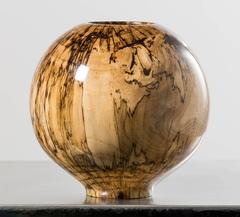Hackberry Wood
Large Wood Turned Hackberry footed Bowl. Dyed. Master Art Wood Turner Carmie
By Carmie
Located in San Antonio, TX
Carmie (Born 1959) Dyed Hackberry Bowl Height 4'' Diameter 8.75''
Bio
Carmie (1959-)
Wood
Category
2010s Modern More Art
Materials
Wood
$325
H 4 in W 8.75 in D 8.75 in
Large Wood Turned Hackberry Vase. Turned and Dyed. Master Wood Turner Carmie
By Carmie
Located in San Antonio, TX
Carmie (1959-) Large Hackberry Vase, Height 12" Diameter 6''
Bio
Carmie (1959-)
Wood
Category
2010s Modern More Art
Materials
Wood
$399
H 12 in W 6 in D 6 in
Recent Sales
Spalted Hackberry 360
By Philip Moulthrop
Located in Phoenix, AZ
turned wood
Philip Moulthrop approaches his practice with the goal in mind to reveal the beauty
Category
2010s More Art
Materials
Wood
People Also Browsed
San Diego California Design Hand Turned Mesquite Wood Art Bowl by Sally Ault
By Bob Stocksdale
Located in San Diego, CA
Expertly crafted Mesquite wood turned bowl by San Diego artist/craftsman Sally Ault. Signed on the underside. Wonderful shape and form. The natural wood grain pattern and color makes...
Category
Late 20th Century American Modern Decorative Bowls
Materials
Wood
$280 Sale Price
20% Off
H 2.5 in Dm 4.25 in
Mesquite hollow form vase/bowl. Natural Art Wood Turning
By Carmie
Located in San Antonio, TX
Carmie (Born 1959) Rustic Mesquite Hollow Form Vase/Bowl Height 4.5" Diameter 5''Biography
Bio
Carmie (1959-)
Wood Turner Carmie K. Acosta was born and raised in San Anton...
Category
2010s Modern More Art
Materials
Wood
$399
H 4.5 in W 5 in D 5 in
Mesquite hollow form bowl. Natural Art Wood Turning
By Carmie
Located in San Antonio, TX
Carmie (1959-) Mesquite Hollow Form Height 2.5'' Diameter 7.5''
Bio
Carmie (1959-)
Wood Turner Carmie K. Acosta was born and raised in San Antonio. By day he works as a syntheti...
Category
2010s Modern More Art
Materials
Wood
$299
H 2.5 in W 7.5 in D 7.5 in
Get Updated with New Arrivals
Save "Hackberry Wood", and we’ll notify you when there are new listings in this category.
Hackberry Wood For Sale on 1stDibs
Find the exact hackberry wood you’re shopping for in the variety available on 1stDibs. When looking for the right hackberry wood for your space, you can search on 1stDibs by color — popular works were created in bold and neutral palettes with elements of brown. These artworks were handmade with extraordinary care, with artists most often working in wood. If space is limited, you can find a small hackberry wood measuring 1.5 high and 2 wide, while our inventory also includes works up to 8.75 across to better suit those in the market for a large hackberry wood.
How Much is a Hackberry Wood?
The average selling price for a hackberry wood we offer is $300, while they’re typically $170 on the low end and $399 for the highest priced.
